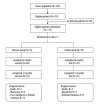Intradialytic Exercise: Effects on Arterial Stiffness and Gait Speed in Patients Undergoing Hemodialysis
- PMID: 40251803
- PMCID: PMC12016671
- DOI: 10.12659/MSM.947604
Intradialytic Exercise: Effects on Arterial Stiffness and Gait Speed in Patients Undergoing Hemodialysis
Abstract
BACKGROUND The benefits of exercise for vascular and physical health in patients on chronic hemodialysis (CHD) are controversial. This study evaluated the outcomes of an intradialytic aerobic exercise program on carotid-femoral pulse wave velocity (cfPWV, an index of arterial stiffness), gait speed, and a sit-to-stand test in patients with CHD. MATERIAL AND METHODS A total of 114 CHD patients were randomly assigned to the exercise or the control (regular care) group. Patients performed intradialytic cycling exercises (3 sessions/week for 12 months) for 20 minutes in a supine position and the exercise protocol was set at a low-to-moderate intensity, defined as activities eliciting 3 to 5.9 metabolic equivalents. Data on cfPWV, gait speed, and the 5-times sit-to-stand test were collected. cfPWV was determined from the time taken for the arterial pulse to propagate from the carotid to the femoral artery and were compared between the 2 groups. RESULTS Arterial stiffness was improved, as evidenced by a significant decrease in cfPWV, in the exercise group compared to the control group (p<0.001). Generalized estimating equations analysis revealed a reduction in cfPWV at 6 and 12 months after the exercise intervention (p<0.001). Gait speed was significantly faster in the exercise group than in the control group (p=0.019). No exercise-related adverse events were reported. Results of 5-times sit-to-stand and body composition did not differ significantly between the 2 study groups. CONCLUSIONS Intradialytic cycling exercise significantly improved cfPWV and gait speed in CHD patients during the 12-month study period.
Conflict of interest statement
Figures



Similar articles
-
Serum osteoprotegerin is an independent marker of central arterial stiffness as assessed using carotid-femoral pulse wave velocity in hemodialysis patients: a cross sectional study.BMC Nephrol. 2019 May 23;20(1):184. doi: 10.1186/s12882-019-1374-2. BMC Nephrol. 2019. PMID: 31122190 Free PMC article.
-
The Impact of Intradialytic Pedaling Exercise on Arterial Stiffness: A Pilot Randomized Controlled Trial in a Hemodialysis Population.Am J Hypertens. 2018 Mar 10;31(4):458-466. doi: 10.1093/ajh/hpx191. Am J Hypertens. 2018. PMID: 29126178 Clinical Trial.
-
Volume status and arterial blood pressures are associated with arterial stiffness in hemodialysis patients.Int J Artif Organs. 2018 Jul;41(7):378-384. doi: 10.1177/0391398818778212. Epub 2018 May 28. Int J Artif Organs. 2018. PMID: 29806514
-
Association of time spent in physical activities and sedentary behaviors with carotid-femoral pulse wave velocity: A systematic review and meta-analysis.Atherosclerosis. 2018 Feb;269:211-218. doi: 10.1016/j.atherosclerosis.2018.01.009. Epub 2018 Jan 17. Atherosclerosis. 2018. PMID: 29407596
-
The Effect of Aerobic Exercises on Arterial Stiffness in Older People: A Systematic Review and Meta-Analysis.Gerontologist. 2024 May 1;64(5):gnad123. doi: 10.1093/geront/gnad123. Gerontologist. 2024. PMID: 37656163
References
-
- Blacher J, Guerin AP, Pannier B, et al. Impact of aortic stiffness on survival in end-stage renal disease. Circulation. 1999;99(18):2434–39. - PubMed
-
- Vlachopoulos C, Aznaouridis K, Stefanadis C. Prediction of cardiovascular events and all-cause mortality with arterial stiffness: A systematic review and meta-analysis. J Am Coll Cardiol. 2010;55(13):1318–27. - PubMed

